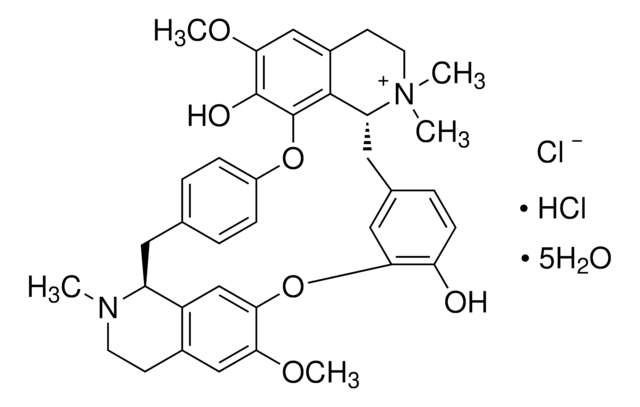C4382
Carbamoylcholine chloride
≥98% (titration), crystalline
Synonym(s):
(2-Hydroxyethyl)trimethylammonium chloride carbamate, Carbachol, Carbamylcholine chloride
About This Item
Recommended Products
assay
≥98% (titration)
form
crystalline
color
white
mp
210 °C (dec.) (lit.)
solubility
H2O: 1 g/mL
ethanol: 20 mg/mL
SMILES string
[Cl-].C[N+](C)(C)CCOC(N)=O
InChI
1S/C6H14N2O2.ClH/c1-8(2,3)4-5-10-6(7)9;/h4-5H2,1-3H3,(H-,7,9);1H
InChI key
AIXAANGOTKPUOY-UHFFFAOYSA-N
Gene Information
human ... CHRM1(1128) , CHRM2(1129) , CHRM3(1131) , CHRM4(1132) , CHRM5(1133) , CHRNA2(1135)
mouse ... Chrm1(12669)
rat ... Chrm1(25229) , Chrm2(81645) , Chrm3(24260) , Chrna2(170945) , Chrna3(25101) , Chrna4(25590)
Looking for similar products? Visit Product Comparison Guide
Application
- to stimulate insulin secretion in transgenic mice
- to induce contraction of undifferentiated and differentiated human adipose-derived stem cells (hASCs)
- to mediate constriction of iris in pupillary light reflex studies in mice
Biochem/physiol Actions
Features and Benefits
signalword
Danger
hcodes
Hazard Classifications
Acute Tox. 2 Oral
Storage Class
6.1A - Combustible acute toxic Cat. 1 and 2 / very toxic hazardous materials
wgk_germany
WGK 3
flash_point_f
Not applicable
flash_point_c
Not applicable
ppe
Eyeshields, Faceshields, Gloves, type P2 (EN 143) respirator cartridges
Certificates of Analysis (COA)
Search for Certificates of Analysis (COA) by entering the products Lot/Batch Number. Lot and Batch Numbers can be found on a product’s label following the words ‘Lot’ or ‘Batch’.
Already Own This Product?
Find documentation for the products that you have recently purchased in the Document Library.
Customers Also Viewed
Our team of scientists has experience in all areas of research including Life Science, Material Science, Chemical Synthesis, Chromatography, Analytical and many others.
Contact Technical Service











